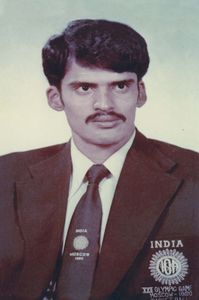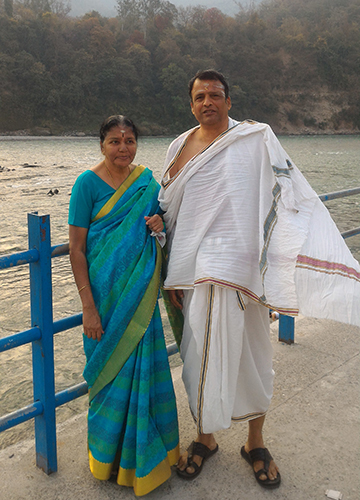For Swami Nateshananda Saraswati, 70, shooting a basketball remains a meditative practice. In his purvashrama―the life before becoming a sanyasi of Advaita philosophy―he was N. Amarnath, a basketball star who represented India in the 1980 Moscow Summer Olympics and led the Indian team in the 1982 Asian Games. In his prime, scoring field goals brought him immense joy. Today, his ultimate goal is moksha or liberation and oneness with Brahman, the supreme cosmic power in Advaita.
Being at the ‘kuticaka’ (first) stage of sanyasa, Saraswati lives alone in a flat in Coimbatore. The colour saffron dominates the decor, including the bedsheets. THE WEEK visited him on the eve of his trip to Rishikesh Dayananda Ashram ahead of Guru Purnima. “Kuticaka sanyasis live in one place, just abiding in the knowledge,” said the Olympian, who embraced the sanyasi life a year after his wife’s death in 2018.
Saraswati believes that destiny has always taken him on routes he had never expected or foreseen. “There are many talented players who played for India. But how many could become captain,” he asked. “Destiny had that for me, even though my parents named me after the legendary cricket captain Lala Amarnath, hoping I, too, would be an Indian skipper one day.”
Born to a Brahmin family in 1954, Saraswati used to be an all-round cricketer during his school days in Periyakulam, a small town in Tamil Nadu’s Theni district. “I was a decent off-spinner and a one-down batsman,” he recalled. However, at the age of 16, he fell in love with basketball. His first coach was town postmaster Padmanabhan, who used to train the youth in his locality in his spare time. He started playing for the sports club and was also part of his college team. Soon, the 5’9” player got jobs under the sports quota, first at Madura Coats, then at the Integral Coach Factory in Chennai and finally at the State Bank of India. Saraswati had great admiration for the ICF team, but back then getting a job in India’s top bank was like a dream come true. “Because of the declaration of Emergency, I had to wait for two years, from 1975 to 1977, to join the bank,” he said. The working hours at the bank gave him ample time to practise daily, and his game improved by leaps and bounds. Little did he know then that destiny had been preparing him and a bunch of others to be India’s first Olympic basketball squad.
In the 1979 Asian Basketball Confederation (ABC) Championship, India came fifth. China was at the top, followed by Japan, South Korea and the Philippines. The tournament finished in the second week of December and almost two weeks later Afghanistan was invaded by Soviet forces.
 All eyes on the ball: Saraswati aka N. Amarnath (jersey no 12) taking a shot against Australia at the Moscow Olympics in 1980.
All eyes on the ball: Saraswati aka N. Amarnath (jersey no 12) taking a shot against Australia at the Moscow Olympics in 1980.
The Summer Olympics of 1980 was scheduled to be held in Moscow, and the American bloc started a movement towards either boycotting the games altogether or moving them out of the Soviet Union to pressure the Soviets to pull out of Afghanistan. The Soviets did not give heed to the deadline declared by the Jimmy Carter administration and this, in turn, pushed US allies to pull their Olympic teams from the Moscow games. Saraswati got selected to the Indian national team for the first time in early 1980 when this boycott movement had been gaining momentum in other parts of the world. “I was selected to the Indian team for a Gulf tour of 10 matches,” he said. “Even then, nobody knew India would go to the Olympics.”
China, the ABC champion, was supposed to play in the Olympics. But China boycotted the Olympics, and so did Japan, South Korea and the Philippines. “So, India got the invitation,” said Saraswati. “It was up to the government to decide whether to send us to Moscow. P.N. Sankaran, then secretary general of the Basketball Federation of India, did an exemplary job of persuading the government. He convinced the authorities that the Olympic team could be selected from the inter-zone championship and could be trained for a month before being sent to Moscow.”
Legendary Services coach Captain M. Rajan, while picking the squad for Moscow, considered only merit and discipline. That helped Saraswati earn a place in the team, despite being one of the shortest players. The team had its pre-Olympics practice season at the Netaji Subhas National Institute of Sports, Patiala.
“I was then working in a branch where many exporters [were clients]. The exporters and the bank staff gifted me a thick brown leather overcoat to beat the cold weather in Russia,” recalled Saraswati. “When we landed in Russia, it was 18°C. The days were too long and nights were short. For the first time, we were going beyond the Gulf and Asia to play. There was real excitement.”
The Indian team was not comparable with the other teams. “But we went there with the attitude that we must do our best, play a good game and also learn,” said Saraswati. “Back then, we did not have TVs. So, we did not even know how the other teams would play. Embassies used to arrange some screenings. That way, we saw videos of American players playing. That’s it.”
The Games Village in itself was a wonder for the Indian team. “We were surprised to find a machine that had juice coming out on the press of a button,” recalled Saraswati. “It was almost 45 years ago. We had seen only water taps until then, not juice vending machines.” India was placed in Group A along with host Soviet Union, who were the favourites to win gold. “And, our opening match itself was against the host in a 60,000-capacity indoor stadium,” said Saraswati, adding that they were not too fussed about it as India had nothing to lose. India finished last in the 12-team event. “We had hoped to give a good challenge to Senegal,” recalled Saraswati. But Senegal, too, beat India 81-59 in a match for minor placing.
After the Olympics, Saraswati found a place on the Indian team that went to the ABC Championship held in Kolkata in 1981 and an international tournament in South Korea in 1982. Before the Asian Games in New Delhi in 1982, he was made the captain of the Indian team. “I came to know about it when I went to write a bank-related exam in Delhi. I bought a newspaper and saw the news that I was made captain,” he said. Under his leadership, India had some memorable performances at the Asian Games, although the team only secured the eighth position in the tournament. Against the powerful Philippines, India delivered a tight fight, losing by only eight points (108-100).
In 1983, Saraswati had a knee injury, but did not undergo surgery. Since then, his performance declined as jumping became painful. He was dropped from the national team and he turned to coaching for a while. Soon, he ended his basketball career to focus on banking.
During this phase, he met Malathi, who also worked at the bank. “It was a love marriage,” said Saraswati. In the early 1990s, the couple developed an interest in spiritual learning, which was further influenced by their transfer from Chennai to Coimbatore. “It was like my guru was waiting for me in Coimbatore,” he said. “On the day we arrived, a neighbour invited me to Bhagavad Gita sessions in his flat. He told me that brahmachari Dheera Chaithanya, a disciple of Swami Dayananda Saraswati, [who had founded various centres for teaching Vedanta around the world and is said to be Prime Minister Narendra Modi’s spiritual guru], was coming to give lessons. Later when my guru took sanyasa, he took the name Swami Sudheerananda. There are 700 shlokas in Bhagavad Gita, and from 1995 to 2004, we studied Gita under him.” Saraswati said that job transfers usually happened every three years. But his transfer order came only after he had completed learning the 700 shlokas.
The couple had a great devotion to their guru. In the early 2000s, Malathi received a mantra deeksha from Swami Sudheerananda―a secret mantra to chant with faith and devotion. Almost 15 years later, despite his failing health and being confined to a wheelchair, Sudheerananda travelled to Rishikesh to initiate his Olympian disciple to sanyasa on July 16, 2019.
Saraswati retired from SBI in 2014 after 37 years of service across 16 branches. Malathi and he initially wished to settle in Srirangam, a neighbourhood in the city of Tiruchirappalli. However, he believes that destiny brought him back to Coimbatore, where he bought a flat to be close to his guru.
Post retirement though, basketball made a comeback in Saraswati’s life. Close to his flat is the Perks Public School where K. Murugesan, currently coach for the Tamil Nadu women’s junior basketball team, trains grassroots-level talents. The Olympian is a regular visitor to the court. Now, except for the times when he is in Rishikesh or on spiritual journeys, he visits the court to meet young players. He, however, says that post Olympics, India’s sports system failed to utilise the experience gained by the only Olympian basketball players. But he has no complaints, only acceptance of life as it is.
“Basketball, Bhagavad Gita and Brahma Sutras are three things I learned in this life,” he said, adding that he continues to be a student of Vedanta and is living in the light of the knowledge that “everything is one with the supreme Brahman”.




